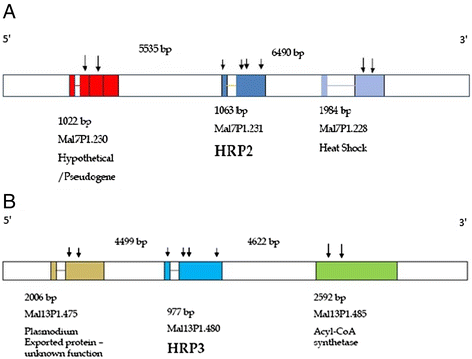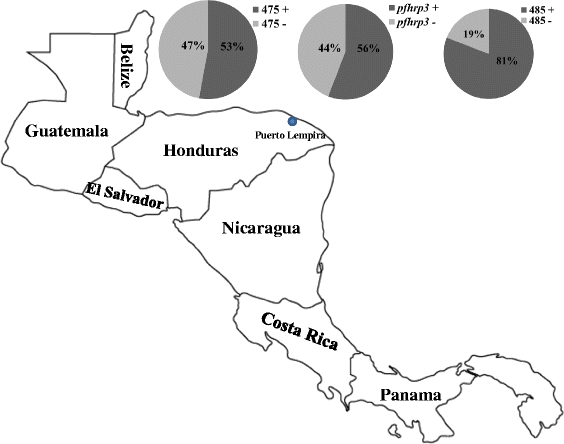Prevalence of pfhrp2 and pfhrp3 gene deletions in Puerto Lempira, Honduras
- PMID: 25604310
- PMCID: PMC4308922
- DOI: 10.1186/s12936-014-0537-7
Prevalence of pfhrp2 and pfhrp3 gene deletions in Puerto Lempira, Honduras
Abstract
Background: Recent studies have demonstrated the deletion of the histidine-rich protein 2 (PfHRP2) gene (pfhrp2) in field isolates of Plasmodium falciparum, which could result in false negative test results when PfHRP2-based rapid diagnostic tests (RDTs) are used for malaria diagnosis. Although primary diagnosis of malaria in Honduras is determined based on microscopy, RDTs may be useful in remote areas. In this study, it was investigated whether there are deletions of the pfhrp2, pfhrp3 and their respective flanking genes in 68 P. falciparum parasite isolates collected from the city of Puerto Lempira, Honduras. In addition, further investigation considered the possible correlation between parasite population structure and the distribution of these gene deletions by genotyping seven neutral microsatellites.
Methods: Sixty-eight samples used in this study, which were obtained from a previous chloroquine efficacy study, were utilized in the analysis. All samples were genotyped for pfhrp2, pfhrp3 and flanking genes by PCR. The samples were then genotyped for seven neutral microsatellites in order to determine the parasite population structure in Puerto Lempira at the time of sample collection.
Results: It was found that all samples were positive for pfhrp2 and its flanking genes on chromosome 8. However, only 50% of the samples were positive for pfhrp3 and its neighboring genes while the rest were either pfhrp3-negative only or had deleted a combination of pfhrp3 and its neighbouring genes on chromosome 13. Population structure analysis predicted that there are at least two distinct parasite population clusters in this sample population. It was also determined that a greater proportion of parasites with pfhrp3-(and flanking gene) deletions belonged to one cluster compared to the other.
Conclusion: The findings indicate that the P. falciparum parasite population in the municipality of Puerto Lempira maintains the pfhrp2 gene and that PfHRP2-based RDTs could be considered for use in this region; however continued monitoring of parasite population will be useful to detect any parasites with deletions of pfhrp2.
Figures



References
-
- WHO . World malaria report 2011. Geneva, Switzerland: World Health Organization; 2011.
-
- PAHO. Malaria surveillance indicators. http://ais.paho.org/phip/viz/malaria_surv_indicators_popup.asp
-
- WHO . World malaria report 2013. Geneva, Switzerland: World Health Organization; 2013.
-
- Lee N, Baker J, Andrews KT, Gatton ML, Bell D, Cheng Q, et al. Effect of sequence variation in Plasmodium falciparum histidine- rich protein 2 on binding of specific monoclonal antibodies: implications for rapid diagnostic tests for malaria. J Clin Microbiol. 2006;44:2773–8. doi: 10.1128/JCM.02557-05. - DOI - PMC - PubMed
Publication types
MeSH terms
Substances
LinkOut - more resources
Full Text Sources
Other Literature Sources
Medical

